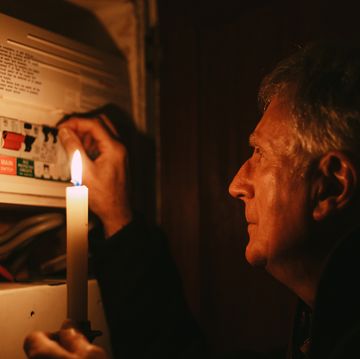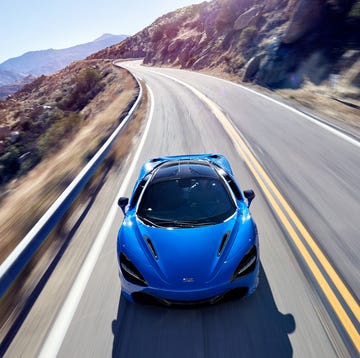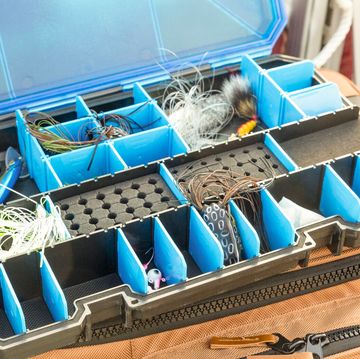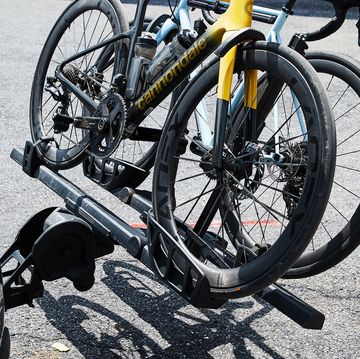On a recent Thursday morning, Mike Lin pulled a cherry-red, 59-passenger bus up to the curb along Allen Street in lower Manhattan's Chinatown. A handful of people had gathered on the sidewalk, and as they climbed into the coach, Lin stepped down from the driver's seat to help a bearded young man load an oversize green backpack and a pair of wooden stilts into the luggage compartment. For the past four years Lin has worked full-time for a small bus company called Eastern Coach, usually driving a daily New York-to-D.C. round trip. He leaves the curb at 10 am and, if traffic is light, arrives in Washington, D.C., by 3 pm. At 4, he pulls away from the curb again, hoping to deliver his passengers—who pay $20 one way—to Chinatown before 9:30 pm. After that, he returns the bus to a Brooklyn parking lot and takes the subway home to Queens. If he's lucky, he's in the door by midnight.
Lin used to work for a more established company, but he didn't like the rules: "I had to wear a uniform. I couldn't talk to passengers while driving. I couldn't smoke around the bus," he says. His old company usually hired separate drivers for the trips to and from D.C., and the bus was equipped with a speed governor that prevented the driver from breaking the posted limit. "Everybody speeds a little," says Lin, who traveled at a steady 70 mph along a stretch of highway marked at 55 while many passengers dozed in the half-empty bus. What none of them knew was that Eastern has one of the worst safety records of any American bus company, ranking in the top 5 percent in unsafe-driving violations.
More than 750 million passengers travel by motor coach each year—more than those who take Amtrak and domestic flights combined. The number is up recently, due in part to the weak economy—when money is tight, people take the bus. Nowadays, they have an abundance of options. Dozens of new carriers have joined established companies such as Greyhound and Peter Pan. Many of them, like Eastern, are curbside operators that keep overhead low by forgoing a terminal and picking up and dropping off passengers on a public street.
But there's a hidden cost to a cheap ride, as the nearly 30 fatalities from bus accidents in 2011 illustrate well. March was a particularly bad month, beginning with a grisly crash in the Bronx. A bus returning to New York City's Chinatown from the Mohegan Sun casino in Connecticut flipped on its side and skidded into a highway signpost, killing 15 people and injuring 18 more. Two days later, an accident on the New Jersey Turnpike killed one passenger and the driver. One week later, a chartered motorcoach rolled over on a New Hampshire highway, resulting in several serious injuries.
On May 31, there was another deadly crash on Interstate 95, just outside Doswell, Va. The motorcoach, operated by a company called Sky Express, was in the right-hand lane just before 5 am, halfway through a 10-hour trip from North Carolina to New York City. As the highway curved gently to the left, the driver—who later admitted to falling asleep at the wheel—didn't alter course. The bus traversed a section of rumble strips before it crossed the shoulder entirely and kept going onto a grass embankment. It careened 381 feet before it rolled onto its roof and finally skidded to a rest another 80 feet from where it had left the highway.
The roof was crushed and the windows shattered. Like most motorcoaches, the 37-year-old bus had no passenger seatbelts. First responders were faced with chaos: From inside the bus came groans of pain and screams for help. Outside, broken glass, duffel bags, and suitcases littered the ground. All 58 passengers had to be transported to area hospitals, dozens with serious injuries. Four passengers died. The only person who didn't require professional medical care was the driver, 37-year-old Kin Yiu Cheung. He was also the only person on the bus whose seat was equipped with a seatbelt.
For many years, intercity bus travel was extremely safe. In the 1980s and 1990s, there were about six to 10 motorcoach fatalities annually (a figure that includes intercity buses and chartered tour buses but excludes school buses and municipal city buses). Then a disturbing trend emerged. "We started to see the numbers creep up to around 25 to 30 fatalities a year, which worried us considerably," says Norm Littler, executive director of the Bus Industry Safety Council, a group of industry veterans that develops and promotes motorcoach safety procedures.
The increased risk corresponds to the rapid growth of bus carriers in the late 1990s, Littler says. "There was a lot of capital around. The bus manufacturers started doing what [automakers in] Detroit did: They would build buses when they didn't have sales, put them on the lots, and basically try to collar anybody into buying one." At the time, Littler was getting frequent calls from people who wanted to start bus companies. "I would go through the various regulatory requirements, and it became very obvious very quickly they didn't care about that," he says.
Then, on Mother's Day in 1999, a chartered bus destined for a Mississippi casino ran off the road and plowed through a chain-link fence and into an embankment. Twenty-two people were killed and another 22 injured. "The driver should never have been behind the wheel," Littler says. "He had severe medical problems. He had a long history of drug use. It was a relatively new company that grew very rapidly and simply should not have been in operation."
The crash turned out to be a harbinger. Between 1999 and 2009, 251 people were killed in 67 motorcoach crashes, according to a study by the American Bus Association. More than half the deaths took place on carriers that had already been cited by federal inspectors for unsafe practices; many of those were newcomers to the industry.
The division of the department of Transportation charged with governing bus safety is known as the Federal Motor Carrier Safety Administration (FMCSA). In recent years, the FMCSA has had a hard time keeping up with the expanding and evolving industry. The Mother's Day crash prompted new standards that would require rigorous inspection of any new bus company within its first six months of operation. The federal law included medical requirements for drivers similar to what the Federal Aviation Administration mandates for pilots. Enforcement, though, remains weak. The driver in the March 2011 Bronx crash was working under a false name. Cheung, the driver in the Virginia crash, could not speak English, even though federal law requires it. Bus drivers are supposed to keep a log of their duty hours, and many companies use electronic punch-in systems to prevent the fudging of paper records. Sky Express relied on old-fashioned paper logbooks, and Cheung—who was charged with reckless driving and involuntary manslaughter—hadn't updated his for two days. His behavior was not unusual. And neither was his ability to get away with it before the deadly accident.
As it turned out, the FMCSA had cited Sky Express drivers for fatigue an astounding 48 times in the two years preceding the Virginia crash. The company had violations for unsafe driving, vehicle maintenance, and hours-of-service rules that dictate how long a driver can remain behind the wheel. The upstart carrier—which owned 31 buses and employed 53 drivers—had had four prior highway accidents and the single worst score of any American bus company in the Driver Fitness category. Still, the FMCSA hadn't taken Sky Express off the road.
Michele Beckjord, a survival factors expert at the National Transportation Safety Board (NTSB), says this isn't unusual. "We've got a lot of unsafe carriers that are getting a 'Satisfactory' rating, but they've got major violations either in maintenance or in driver performance and behavior." The problem, she says, is that in order to reach the Unsatisfactory level in the FMCSA's numerical evaluation system, a bus carrier has to have terrible scores in several different areas.
>
CONTINUED >>>
History has shown that in most fatal crashes, driver performance is the biggest factor. "In the past, we looked at motorcoach drivers as being the crème de la crème, the kind of folks who make driving an art," says Stephen Evans, head of safety for Pacific Western, one of North America's biggest bus companies. "We thought there wasn't a need to be watching over them. That's not as true anymore."
Last year, the DOT adopted new rules stipulating that all applicants for commercial driver's licenses (CDLs) be required to get a learner's permit; previously, passing a state-specific written test was all that was required. The rules also require states to begin using a standardized CDL test and to ban the use of foreign-language interpreters, who in some cases are thought to perpetuate testing fraud. States have until 2014 to come into compliance. The law also needs to be revised to allow a driver's CDL to be revoked for drunk driving or other offenses committed in noncommercial vehicles, the DOT said.
Right now, someone rejected from a job trucking hazardous materials because of something in his background check can go out and get a passenger-bus license. Lack of law enforcement on the roads is another issue. Bus drivers know they're unlikely to be pulled over by police officers, who don't want to deal with a busload of annoyed passengers. As a result, they feel invulnerable and often get away with chronic reckless driving that, say, a professional truck driver never could.
Following last Spring's spate of deadly crashes, the FMCSA made efforts to step up its enforcement. In early May, the agency conducted 3000 unannounced safety inspections that led to 315 unsafe buses and 127 unfit drivers being taken off the road. Between January and October 2011, it shut down 37 unsafe bus companies and proposed an unsatisfactory rating for more than a dozen more. Those companies normally have 45 days to appeal the FMCSA's findings—unless they're found to pose an imminent hazard, like the Michigan company that was discovered to be transporting passengers in the cargo hold. (There were no seats for the six people inside the bus, the owner explained.) The company had been fined for the same violation the year before, when off-duty drivers were found to be using the underbelly as a sleeping berth.
Once behavior becomes egregious enough for the FMCSA to order a company shuttered, a secondary challenge is posed by so-called chameleon operations. "The problem they're having now is finding these companies that want to hide from them," Littler says. "They change names, they use false DOT numbers, they park their buses in different locations. They don't want to be found."
After the Doswell, Va., crash, the FMCSA issued Sky Express an Unsatisfactory safety rating, which placed the company out of service. Within days, Sky Express had reincarnated itself, with the same management selling tickets for the same buses under the company names 108 Tours and 108 Bus. Tickets were available from a variety of websites, including 2001bus.com, gotobus.com, and taketours.com.
"This behavior by a few is outrageous and must be stopped," FMCSA head Anne Ferro testified before Congress in June. By then, the agency had issued a cease-and-desist letter to Sky Express. "This year has been the worst period in recent history for motorcoach safety," she said. Ferro explained that loose leasing practices allow rogue carriers to escape detection, while unregulated websites broker and sell tickets with no transparency to the public.
Ferro argued that her agency needs more congressional authority to tighten the net around unsafe operators. It needs the power to require safety audits before a carrier ever starts operating. (Today, a new company can transport passengers after two online payments of just $300.) It needs to be able to conduct unannounced, en route inspections at rest stops or other safe pull-offs, rather than before or after trips as is now the norm. And it needs a way to stop "new" companies that rise from the ashes of unsafe carriers. A good start, she said, would be to raise the penalty for companies that attempt to operate without DOT authority from the current $2000 a day to $25,000 per violation.
Technology upgrades would no doubt save lives, too. The bus industry has lagged behind passenger vehicles when it comes to safety advances. While annual interstate bus fatalities have risen, overall road deaths are down 25 percent since 2005 and are now at a historic low. Safer roads, stepped-up enforcement, and stricter teenage-driving and drunk-driving laws are responsible for much of the drop. But the now-ubiquitous use of seatbelts, stronger vehicle construction, and technologies like antilock braking in cars have also made a big difference.
About 70 percent of people killed in bus crashes are ejected from the vehicle; break-free glass and stronger construction standards for roofs would reduce the death toll. (In the Bronx crash, the signpost sliced through the bus, peeling the roof back like the lid on a can of sardines.) Antilock brakes should be standard in motorcoaches, which take much longer than passenger cars to slow and stop. And though the NTSB first recommended mandatory seatbelts in buses in 1968, they're still uncommon. Some manufacturers have begun building vehicles with three-point belts, but a DOT proposal to require belts in every new bus would speed this transition.
A smartphone app that ranks all carriers in a given departure city by their safety scores would go a long way toward helping travelers choose wisely. In the meantime, passengers can be proactive about minimizing risk: Bus companies' safety data can be searched on the FMCSA's website (look for Bus & Passenger Carrier Safety under Quick Links).
But for too many people, budget trumps safety concerns. Zhenjiang Qian, a Chinese tourist who was traveling to D.C. aboard Mike Lin's Eastern Coach route, had read about some of the recent bus accidents in the paper but still opted for a low-cost ride. "The bus tickets at Port Authority [New York City's bus terminal] cost $70 round-trip," he told a reporter. "This one is much cheaper." Absent stricter regulation, the seats of unsafe carriers remain filled. To Qian and others, until the worst happens, a $20 ticket seems worth the gamble.













